The Evolving Landscape Of Online Gaming: Monetization Strategies For 2025 And Beyond
The Evolving Landscape of Online Gaming: Monetization Strategies for 2025 and Beyond
Related Articles: The Evolving Landscape of Online Gaming: Monetization Strategies for 2025 and Beyond
Introduction
In this auspicious occasion, we are delighted to delve into the intriguing topic related to The Evolving Landscape of Online Gaming: Monetization Strategies for 2025 and Beyond. Let’s weave interesting information and offer fresh perspectives to the readers.
Table of Content
The Evolving Landscape of Online Gaming: Monetization Strategies for 2025 and Beyond

The online gaming industry is a dynamic landscape, constantly evolving with technological advancements and changing player preferences. As we approach 2025, the monetization models within this industry are expected to become even more diverse and innovative, offering new avenues for players to generate income while engaging in their favorite pastime. This article delves into the key trends shaping the future of online gaming monetization, exploring various strategies and their implications for both players and game developers.
The Rise of Play-to-Earn (P2E) and the Metaverse:
One of the most significant shifts in online gaming monetization is the emergence of Play-to-Earn (P2E) models. These models, often associated with blockchain technology and the metaverse, allow players to earn real-world value through in-game activities. This value can take various forms, including cryptocurrencies, non-fungible tokens (NFTs), and virtual assets that can be traded on secondary markets.
The P2E concept has captured significant attention, with games like Axie Infinity and Decentraland showcasing its potential. These games allow players to acquire in-game assets, breed virtual creatures, and participate in the virtual economy, potentially generating income through trading, breeding, or participating in events.
However, P2E models are not without their critics. Concerns exist regarding the potential for exploitation, environmental impact, and the potential for market manipulation. Further, the regulatory landscape surrounding P2E is still evolving, and legal ambiguities remain.
Beyond P2E: Expanding Monetization Options:
While P2E models are attracting considerable interest, it is crucial to understand that they are not the only avenue for monetization in the future of online gaming. Several other strategies are likely to co-exist and evolve alongside P2E:
- Subscription Services: Subscription models, already prevalent in games like World of Warcraft and Fortnite, will continue to flourish. These models offer players access to premium content, exclusive features, and ongoing support in exchange for a recurring fee. The subscription model provides a stable revenue stream for developers and fosters a sense of community among players.
- In-Game Advertising: Targeted advertising within games is becoming increasingly sophisticated. Developers are finding ways to integrate ads seamlessly into the gameplay experience, ensuring they do not disrupt the player’s enjoyment. This model allows developers to monetize their games without relying solely on player spending.
- Microtransactions: Microtransactions, the purchase of in-game items, currencies, or cosmetic enhancements, remain a cornerstone of many games. However, developers are moving away from exploitative practices and focusing on providing value to players through optional, cosmetic purchases.
- Esports and Streaming: The rise of esports and streaming has opened up new avenues for monetization. Players can earn income through sponsorships, prize pools, and content creation, while developers can leverage esports events to attract new players and generate revenue through merchandise and branding opportunities.
- Cross-Platform Collaboration: Developers are increasingly exploring cross-platform collaborations. This involves partnering with other companies to integrate their products and services into games, creating new opportunities for monetization through advertising, product placement, and cross-promotion.
The Importance of Transparency and Player Choice:
As online games evolve, it is essential that developers prioritize transparency and player choice in their monetization strategies. Players should have a clear understanding of how they are earning money and the potential risks involved. Developers should strive to create fair and balanced systems that reward players for their time and effort without resorting to exploitative practices.
Engaging the Player: Building a Sustainable Ecosystem:
The success of any online game hinges on its ability to engage players and build a thriving community. This requires a focus on:
- Quality Gameplay: A compelling gameplay experience remains the foundation of any successful game. Developers must prioritize engaging gameplay mechanics, compelling narratives, and a rewarding progression system.
- Community Building: Cultivating a strong community is crucial for long-term success. Developers should foster communication, encourage player feedback, and create events that bring players together.
- Constant Evolution: The gaming landscape is constantly changing. Developers must adapt to new trends, incorporate player feedback, and continuously update their games to keep players engaged.
FAQs:
1. What are the potential risks associated with P2E models?
- Volatility: Cryptocurrency prices can fluctuate significantly, impacting the value of in-game assets.
- Exploitation: Some P2E games can be designed to incentivize excessive play, potentially leading to addiction or financial hardship.
- Environmental Impact: Blockchain technology, particularly proof-of-work models, can consume significant energy, raising environmental concerns.
- Regulation: The legal landscape surrounding P2E is still developing, and regulatory uncertainties exist.
2. How can developers ensure their monetization strategies are ethical?
- Transparency: Clearly communicate how players can earn money and the potential risks involved.
- Fairness: Design gameplay mechanics that reward players for their time and effort, not just spending.
- Player Choice: Offer optional monetization options and avoid forcing players to spend money to progress.
- Community Engagement: Actively listen to player feedback and address concerns regarding monetization.
3. What are some tips for players looking to earn money from online games?
- Research thoroughly: Understand the game’s mechanics, monetization model, and potential risks before investing time or money.
- Start small: Begin with a modest investment and gradually increase your involvement as you gain experience.
- Diversify your income streams: Don’t rely solely on one game or monetization method.
- Stay informed: Keep up-to-date on industry trends, regulatory changes, and new game releases.
Conclusion:
The future of online gaming monetization is poised for significant transformation. While P2E models offer exciting possibilities, they are not the only path forward. A diverse range of monetization strategies, coupled with a focus on transparency, player choice, and community building, will be crucial for creating a sustainable and rewarding gaming experience for players and developers alike. As the industry continues to evolve, the key to success lies in embracing innovation while prioritizing the needs and well-being of the players who fuel this vibrant and dynamic ecosystem.








Closure
Thus, we hope this article has provided valuable insights into The Evolving Landscape of Online Gaming: Monetization Strategies for 2025 and Beyond. We thank you for taking the time to read this article. See you in our next article!